Fujifilm Finepix J50 Review
Review Date: March 21st 2007
Author: Mark Goldstein
Leave a comment about this Review
|
Introduction
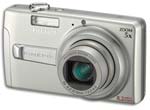
The Finepix J50 is one of two new models in a completely new lineup of beginner-friendly cameras from Fujifilm. First debuted at the PMA show back in January, the J50 represents an attempt to put the style back into affordable, closely resembling the more expensive and well-regarded F-series cameras. Primarily designed to be easy to use and portable, the Fujifilm J50 boasts a straight-forward control layout housed in a slimline 23mm thick body. Even more impressive given its diminuitive dimensions is the 5x optical zoom lens, providing a versatile focal length of 37-185mm. Other standout features include an 8.2 megapixel CCD sensor, 2.7" LCD screen and support for three different memory card formats. Is the J50 a worthwhile addition to Fujifilm's already extensive range of compact digital cameras, or does it simply cut too many corners? Mark Goldstein reviewed the Fujifilm Finepix J50 to find out...
Compare Prices
Support PhotographyBLOG: Buy the Fujifilm FinePix J50 from one of our affiliate retailers:Ease of Use
The Fujifilm Finepix J50 is a compact digital camera that easily fits into both the palm of your hand and a trouser pocket. With dimensions of 95.6(W)x55.4(H)x23.0(D)mm and weighing only 141g, this is a camera that you can slip into a pocket or small bag and not notice until you need to use it. The Fujifilm Finepix J50 is fairly pleasing on the eye, with a stylish silver colour scheme (also available in black) and a slightly rounded, compact appearance. It mimics the excellent overall finish of the Fujifilm Finepix F-series cameras, and whilst not quite up to the same high standard, it undoubtedly looks and feels more expensive than it actually is.
The Fujifilm Finepix J50 is comfortable to hold, with the shooting mode dial on the back of the camera where your right thumb is naturally positioned, and a small lip that acts as a handgrip on the front. Your right forefinger is then free to operate the shutter button and the zoom lever, which surrounds the shutter button. The mode dial allows easy access to the various shooting modes, and the push-pull zoom lever is responsive to use. Despite the smooth all-plastic body, the camera is not too slippy when gripping it. The various buttons are well-made and easy to operate, and the camera feels well-balanced in your hands. The only thing that I didn't like was the USB port, which protrudes from the right side of the camera body. Other than that, the Fujifilm Finepix J50 is well constructed and designed with no obvious signs of corners being cut.
The Fujifilm Finepix J50 has relatively few external controls, just 10 in total, which is perhaps understandable considering that this camera offers very few photographic controls. You can directly access the various flash, macro, self-timer and delete options by clicking on the four buttons around the clicky navigation pad. As with most other Fujifilm digital cameras, the Fujifilm FinePix J50 has a Menu button on the rear of the camera which, as you would expect, gives you access to the software menu system. This lets you set the ISO, quality and, continuous mode when the camera is in Auto mode, and additionally exposure compensation and white balance in the Manual scene mode. This mode is something of a misnomer, as it only provides the two extra settings, and not the control over exposure that you might expect. It's fair to say that the J50 is not the right camera if you require any advanced controls, with only one type of focus and metering on offer, for example.
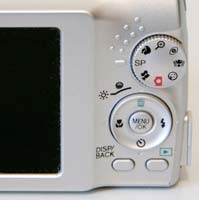 |
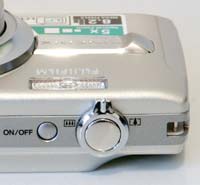 |
| Rear Controls | Top Controls |
As mentioned previously, there is a dial on the back of the camera that you turn to select the various shooting modes (Auto, Movie, Scene Positions, Portrait, Digital Zoom, Red-Eye, Picture Stabilization, Baby Mode). It's quite similar to the system used on many DSLR cameras and allows quick access to the various modes. All 10 external controls are clearly labeled using industry-standard symbols and terminology. Overall the camera body feels well-designed and not at all cluttered, despite the presence of the large 2.7 inch LCD screen. Note that there is no optical viewfinder on the Finepix J50, leading to a few moments of frustration in very bright sunlight when it can be difficult to see the image on the monitor clearly. The J50's LCD monitor has a matt finish, compared to the glossy one on many compacts, and it is also slightly recessed, which should lead to fewer scratches. The resolution of 230,000 pixels and 100% scene coverage are also very welcome.
The Picture Stabilization mode reduces blurry images that can be caused by camera shake or subject movement, especially in low light settings. It automatically chooses the best combination of ISO speed and shutter speed, helping to freeze the action and reduce the blur and noise often associated with low-light photographs. In practice I found that it worked quite well, but it does come at the considerable cost of increasing the ISO speed (more on this later...). Also, it's not as effective as a true optical image stabilisation system, which the J50 is really crying out for given the extensive telephoto zoom range on offer. More than a few shots suffered from noticeable camera shake at the long end of the range, and whilst adding such a feature would have bumped up the price, it would also have made the J50 a much more effective camera.
If you have never used a digital camera before, or you're upgrading from a more basic model, reading the comprehensive and fairly easy-to-follow manual before you start is a good idea. Thankfully Fujifilm have bucked the recent trend of not providing hard-copy manuals and supplied it in printed format. The main menu system on the Fujifilm Finepix J50 is straight-forward to use and is accessed by pressing the Menu/OK button in the middle of the navigation pad. In the Manual scene mode there is a single Shooting menu with 6 options. At the bottom is the Setup option - select this to access 5 more tabbed pages with 15 options that you will probably set once and then forget about. Due to the large LCD screen, the various options and icons are perfectly easy to read.
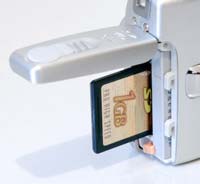 |
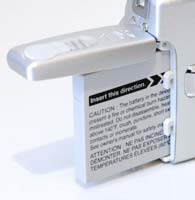 |
| Memory Card Slot | Battery Compartment |
The start-up time from turning the Fujifilm Finepix J50 on to being ready to take a photo is quite quick at around 1.5 seconds, and it takes around the same amount of time to zoom from the widest focal length to the longest. Focusing is quick in good light and the camera achieves focus most of the time indoors, although there is no focus-assist lamp to help out in low-light situations. The visibility and refresh rate of the 2.7 inch LCD screen are good, and the resolution is excellent. In the normal shooting mode it takes about 1 second to store an image, during which you can't take another picture. In Continuous mode the camera takes 2 frames per second at the highest image quality, not particularly quick, and it's limited to only 3 frames. All in all the Fujifilm Finepix J50 is fairly responsive in terms of operational speed.
Once you have captured a photo, the Fujifilm Finepix J50 has quite a good range of options when it comes to playing, reviewing and managing your images. You can scroll through the images that you have taken, view thumbnails (up to 9 on the same screen!), and zoom in and out (albeit annoyingly slowly). You can sort images by date, view slideshows, delete, protect, copy, trim and rotate an image. You can also set the print order and the transfer order. The Display button toggles between no infomration, the thumbnail view, the calendar view, and detailed settings information about each picture, including the ISO rating and aperture/shutter speed. There is no histogram either in shooting or playback mode.
In summary the Fujifilm Finepix J50 is a simple, fairly responsive, point-and-shoot digital camera with the added bonus of a versatile 5x zoom lens.
|
![]() PhotographyBLOG
is a member of the DIWA
organisation. Our test results for the Fujifilm Finepix J50 have been submitted to DIWA
for comparison with test results for different samples of
the same camera model supplied by other DIWA
member sites.
PhotographyBLOG
is a member of the DIWA
organisation. Our test results for the Fujifilm Finepix J50 have been submitted to DIWA
for comparison with test results for different samples of
the same camera model supplied by other DIWA
member sites.
